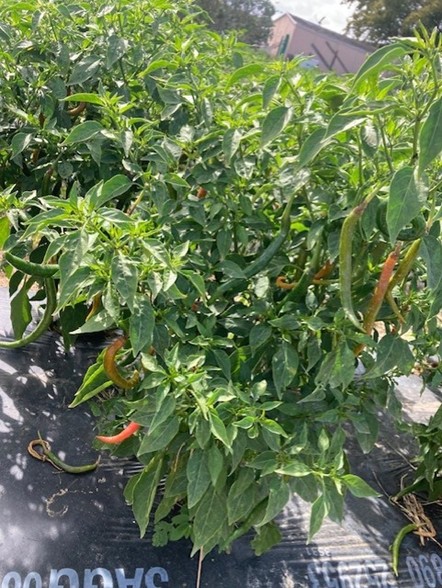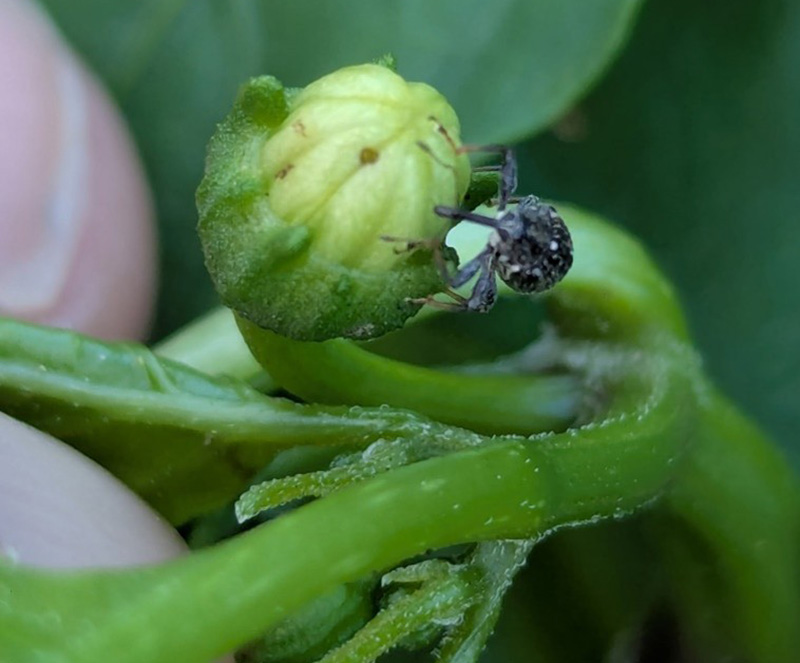Xavier Martini – Associate Professor, UF/IFAS, Jessica Griesheimer – PhD student, UF/IFAS, Marissa Wilson Nodarse – Undergraduate Student, UF North Florida Research and Education Center, Quincy
Peppers, particularly bell and chili peppers, have high economic importance globally and are popular in food preparation as both fresh ingredients and dry spices. Peppers also have a high cultural importance to traditional and ethnic dishes. In the United States, most peppers are produced in California, Florida, Georgia, and New Jersey, and are most used as a fresh ingredient. Florida’s annual pepper production was valued at approximately $188 million in 2023.
Pepper growers face challenges from different viral, fungal, and insect pests. One of the most devastating pests to peppers and the grower’s marketable yield is the pepper weevil, Anthonomus eugenii Cano (Coleoptera: Curculionidae – Figure 1). The pepper weevil is a solanaceous specialist, primarily found to survive on plants in the genera Capsicum and Solanum. The pepper weevil is a small, black weevil with white flecking on its elytra. Pepper weevil infestations can cause a grower to lose between 50 – 80% of their marketable yield in one season. Economic losses in the United States due to pepper weevil infestations have been estimated to be approximately $23 million.
–

Fig. 2: Premature coloration and fallen fruit of Jalapeño due to pepper weevil infestation Credit: Dak Seal, UF/IFAS
Premature yellowing or reddening, damaged, or fallen pepper pods and flowers are often the first visual signs of a pepper weevil infestation (Figure 2). Other signs of a pepper weevil infestation are small feeding hole punctures and larger, circular, adult emergence holes found on pepper pods. By the time multiple pepper pods or flowers have fallen, a serious infestation of the pepper field has often occurred, leading to severe decreases in the marketable yield. Detecting the pepper weevil early in the growing season, before fallen pepper pods or flowers, is crucial to maximizing pest management potential.
Due to their extremely destructive behavior, current management strategies rely heavily on the use of broad-spectrum, contact-based chemical insecticides to control adult weevils in pepper fields. This type of management can quickly reduce the number of adult weevils in a grower’s field but does not target the immature stages of the weevil which are protected inside the pepper fruits. Current action thresholds to begin chemical treatments are extremely low. It is recommended to start applying insecticide when one adult pepper weevil is found per every 400 terminal buds or when it is observed that 1% of their pepper buds are infested with larvae. It is then recommended to continue using chemical sprays throughout the season by rotating the mode of action (MOA) of the insecticides used to prevent the development of resistance within the population. Torac® (Tolfenpyrad, MOA 21A) at 21 fl. oz/Acre, and Belay® (clothianidin, MOA 4A) at 4 fl. oz/Acre, showed significant efficacy in a recent trial conducted at the Southwestern Research and Education Center (Qureshi and Kostyk, 2025); Vydate® (oxamyl, MOA 1A) at 2pt/Acre also provided control against the pepper weevil but at a lower level. For better efficiency, it is recommended to add a nonionic spreader-ticker adjuvant (such as Cohere®).
Due to the growing concern of increased insecticide resistance and the off-target effects chemical insecticides can have on the agroecosystem, organic pest management methods, such as kaolin clay (sold under the brand name Surround®), have been investigated in pepper weevil management. In previous research, kaolin clay-coated peppers showed reduced feeding and adult emergence in both field and greenhouse settings, with some studies indicating that kaolin clay alone could produce similar yield amounts to those of chemical pesticides. As kaolin is an irritant, it is essential that the spray applications are targeted to protect flowers and young fruits.
–
Reference:
Jawwad Qureshi, Barry C Kostyk, Evaluation of foliar applied insecticides for control of pepper weevil. Spring 2024, Arthropod Management Tests, Volume 50, Issue 1, 2025, tsaf026
- Pepper Weevil is a True Menace to Pepper Production - October 3, 2025
- Sap Beetles are Not a Cause of Concern for Citrus but Katydids Are - October 4, 2024
- The Importance of Pollination for Seedless Watermelons and How to Enhance it - April 5, 2024

